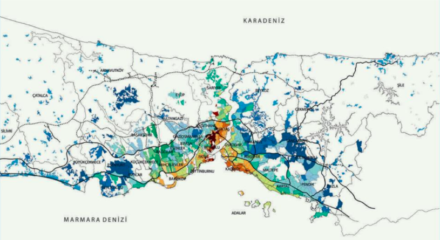Scan and identify
Consider what data will provide the most actionable information

On the ground
Gather and synthesize existing data
What national and municipal data on early childhood development services and indicators already exists? What does it tell you?
The relevance of each data set certainly varies, but identifying existing data on the availability and uptake of social services; health, education, environment, socioeconomic indicators; and family access and use of transportation and public space can illuminate key gaps and needs.
Where do the highest concentration of families in need live?
Consider mapping these areas, particularly for families with children under five, against income levels and other context-specific vulnerability indicators, as well as the location of existing early childhood services and programmes. Keep in mind that many families live in informal settlements or other areas not always captured under formal governance systems. Understanding where these maps overlap and diverge can help inform how and where you implement projects. For example, if the areas with most vulnerable families are the same as those without access to green spaces, you may consider working on improving access to nature.

Tools & resources
What is the day-to-day experience of caregivers moving through the city with babies and toddlers?
Consider conducting surveys or holding focus groups to understand caregivers’ journeys through the city—their stress points and places of refuge. Consider also developing formative research to understand the rationale behind the adoption of certain caregiving behaviours that impacts young child development.
What infrastructure already exists?
What public spaces already exist for families?
I.e., parks and play spaces.
How do transportation services already support families?
I.e., wide pedestrian roads, subsidised family fares for travel,
walkability etc.
What health, education and social services exist for young children and caregivers, and where are they located?
Think about quality, access, coverage, utilisation. Are there any gaps that you can identify? What initiatives already focus on the wellbeing of families, with a specific focus on the relation to the physical environment, or on women and children’s access to the city and services?
Systems-level support
Identify allies and supporters
Who is already advocating for babies, toddlers and caregivers?
Caregiver needs are often invisible to decision makers, and babies and toddlers are unable to speak up for themselves; we believe that advocacy on their behalf is especially important. Which political and civil society leaders, organisations and coalitions are already sensitised to the importance of and need for early childhood development programming? Could they actively support your implementation efforts through their advocacy, influence and budget resources?
Tools & resources
Which leaders, agencies and organisations already work closely with caregivers and children?
These might include individuals and entities engaged in health, education or social services, but they could also be youth movements, environmental NGOs, national governments or community organisations. Does their work touch other areas where bundling of services might be appropriate?
Who are your local experts in early childhood development?
Can you connect them with other stakeholders who can influence the well-being of babies, toddlers and their caregivers, such as city leaders, city managers, politicians, people from the budget allocation ministry/unit, transport agencies, or women’s health frontline workers?
Strive to understand urban or national planning processes in place
What moments of opportunity exist in your city’s planning process?
For Urban95, consider how often municipal plans and regulations are updated, and who updates them. Exploring these processes and the architects behind them can help you identify local timelines with which to align and leaders with whom to engage.
Is a large part of the population living in areas not easily reached by the planning system (informal neighbourhoods)?
Consider alternative ways to reach these population, such as partnering with community organisations and (non-spatial) government initiatives intervening in the area from other agencies such as social services or health.
Tools & resources
Arup’s Early Childhood Urban Framework (informal settlements)
What sources of potential funding exist?
Consider government budgets at various levels and funding from different institutions, international organisations, international development banks, foundations and the private sector. For example, if you’re looking to organise a parent-coaching event in a park, funding could come from social services or health budgets, or from parks and gardens department budgets, or local business owners. Or from a mix of sources. We appreciate that information on funding for early childhood initiatives can feel opaque and inaccessible; we have considerable work ahead of us to try to understand them.